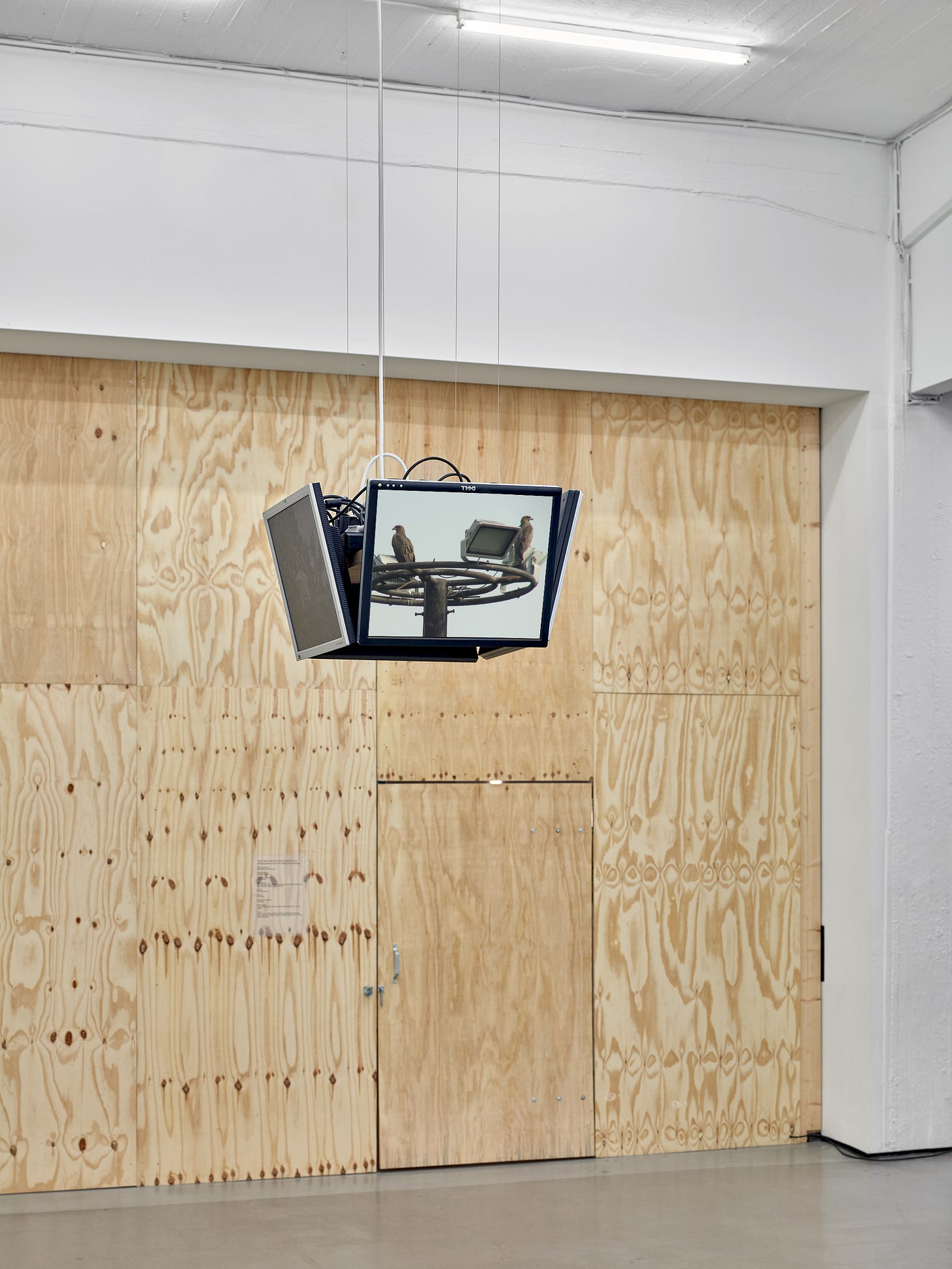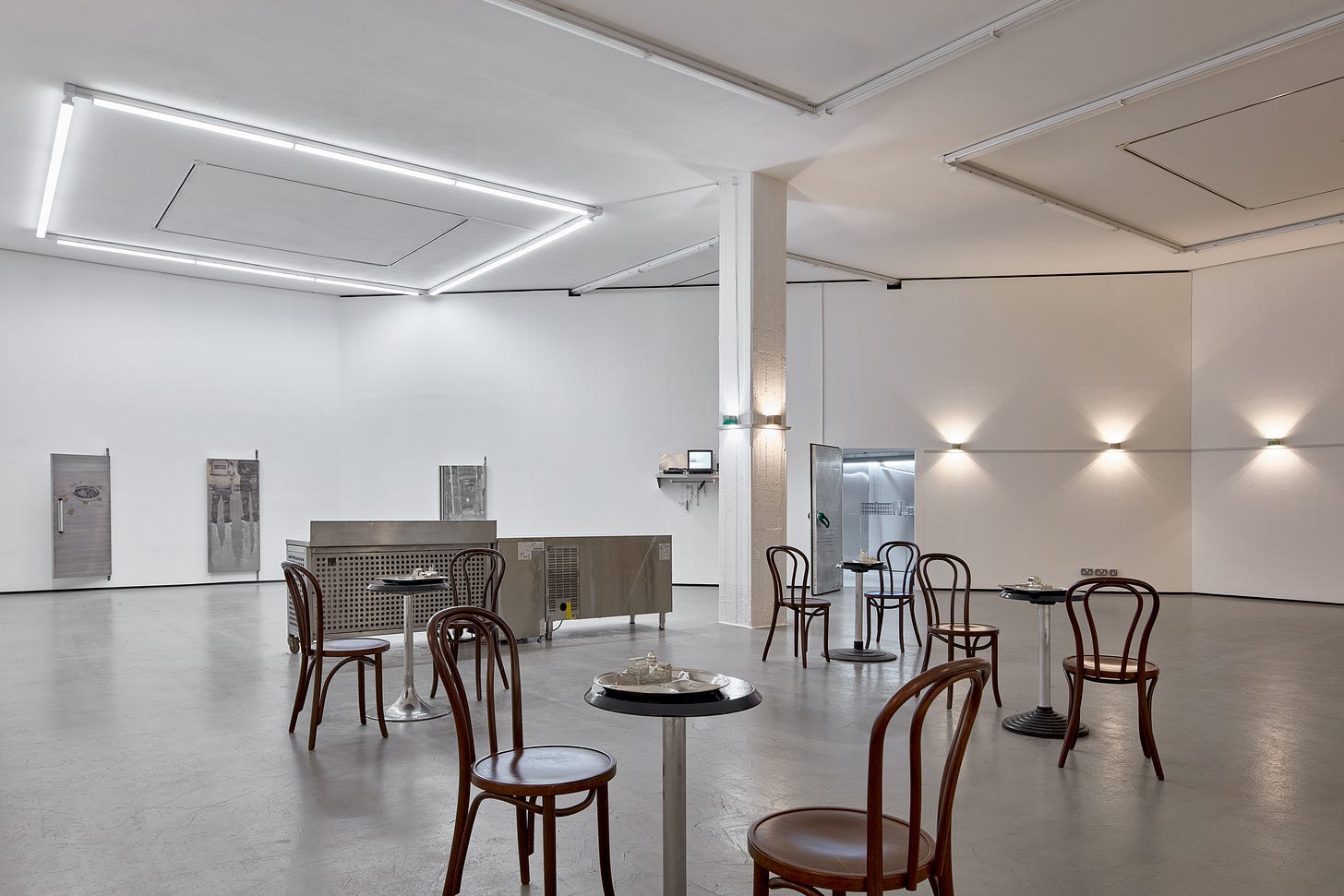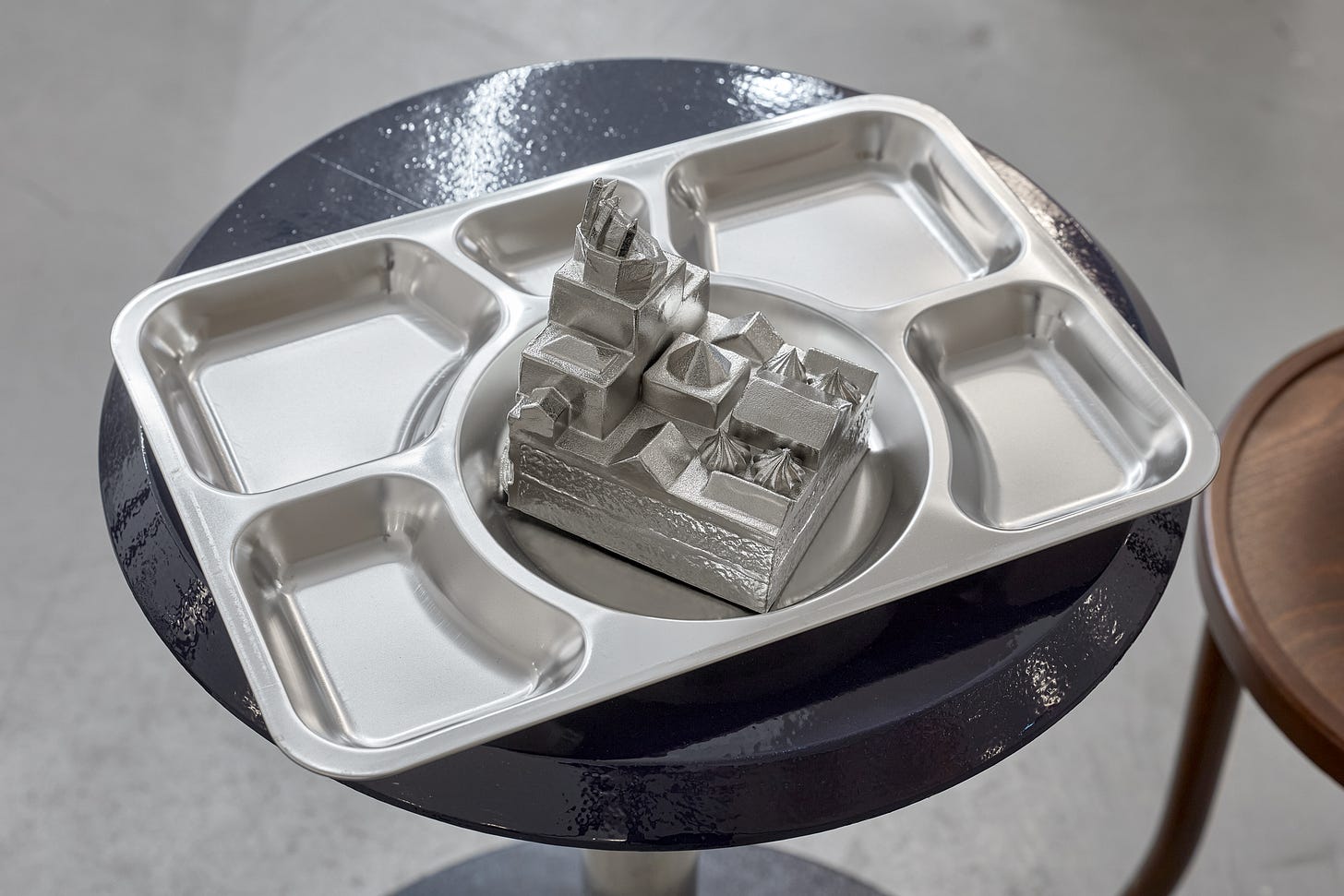Vijan's Eleven: Planning A Heist at Kunstverein in Hamburg
Prateek Vijan's (Millennial, Indian) show plays with the (im)possibility of getting back what's rightfully yours. A thought experiment on crime, institutional dominance, and pretended accessibility.
An Inside Job
It was a Sunday night two weeks ago. Katrin, Martin, and I had just been to the winter graduate show at HfbK (which was awesome btw). There was enough time to catch my train back to Cologne, so we went to the Kunstverein. It was after the opening hours, so Martin had to open the place for us. Seeing the show at night with no other visitors around felt like breaking in, it fit the show’s vibe perfectly. As we left our stuff in the main hall, I was surprised that the back was closed off by a huge wooden wall. I could make out a door. What was behind it?
As Katrin and I waited for Martin to turn on the lights everywhere, we looked at the video Balcony (2024) above us: Footage of falcons sitting on street lights, displayed on four flat screens facing every compass direction. I can’t tell if it’s the same falcon and the same day. The angles alternate. The street light feels useless during the day and the falcon doesn’t fit in with the city skyline in the distance. Katrin took a picture of me taking a picture of the video with the falcon observing the city while we observed it in the show. Like that one chain reaction meme.

The falcon and the street light become stand-ins for surveillance, one technology replacing the other. Did you know that when Paris introduced the first street lamps, people weren’t happy about it? A well-lit street at night feels like a natural feature of a safe environment now, but it didn’t for many people back in the day. I picked up this quote somewhere a while ago1 that said “[t]he gentleman who once could walk unnoticed through the darkness now finds himself illuminated, his every movement tracked by the unblinking eyes of gas flames” (so far, the source remains “trust me, bro”). Even some church representatives argued that an overabundance of artificial light was against God’s natural order when Louis XIV ordered to install first street lanterns. Interestingly, as far as I can tell from the various sources, it’s only men complaining about this novelty… Big hm, that’s sus moment…

Playing the UNO Reverse Card
We walked outside to the back entrance. As Martin got out the keys, I noticed a large glaring green key-shaped shop sign above. Has this always been here? "It’s part of the show”, Martin replied to my thought. It was actually a picklock, not a key. Is the sign advertising an illegal theft service?
Martin opened the door and we entered a sharply angled room with metal plate coating. There’s three metallic architectural models. Martin explained that it’s different parts of the Victoria & Albert Museum in London with corridors and hallways. Prateek undertook meticulous undercover research of the building and its history during a residency in London. He presents hypothetical escape routes through the building. This is so Ocean’s Eleven (2001) of him.
The V&A houses countless artifacts from India which Prateek simply wants to return to their right place. Martin outlined Prateek’s concept of Counterloot: If somebody took something from you and didn’t return it upon your request, you get to steal it back. “Stealing” is an interesting word in this context. What do lawyers see in a counterloot case involving a museum? Is it two thefts? Does the museum taking something away count as theft for them? Or is the counterlooter the only thief in their scenario? The more steps you take back to see the bigger picture, the harder it gets to speak of counterlooting as “stealing.”

The V&A has its own pavilion at the Venice Biennale, did you know? They either present an exhibition that later takes off to their museum or they invite artists to create an exhibition with the V&A collection. I wonder how they’d react to Prateek’s hypothetical call to action… Do they know about it?
Cooking Up Conflict
We get out of the room and into the next one: A metal counter divides the room into a kitchen and a dining hall. We’re on the other side of that wooden wall. The kitchen consists of five metal fridge doors. Prateek used acid to etch in visuals on top. He depicts the security personnel at the V&A. Just like that falcon from earlier, they don’t know they’re being watched. This is so The Menu (2022) when they baked tortillas with scans of that company’s Offshore account invoices.
On the other side of that sterile empty kitchen counter, Prateek arranged chairs and tables. There are metal trays, but not fancy ones. They’re giving hospital food or cheap school canteen. But instead of baked beans and green peas (sorry for my prejudice on Bri’ish cuisine), this café serves cake. Silvery cake. Cake in the shape of the V&A architecture, as Martin clarified. Every cake looked different though, how in the world is that the same building? As I looked it up for this review I went gahdamn, this whole thing really looks like multiple story cream cake from above. There’s something incredibly satisfying to the slowly collapsing and melting shapes of those sugary building parts. Let them eat cake fr.

The V&A actually introduced the first museum café in history: Three restaurants and three menus, each according to your tax bracket. Refined dining halls were reserved for wealthy visitors. Canteens were available to working-class visitors. Returning to the introduction of street lights from earlier: The newly installed gas lamps made late opening hours possible, which working-class visitors benefited especially from. The different menus to fit differing budgets can be seen as a positive development towards the inclusion of economically disadvantaged groups. But remember: Everybody stayed in their own lane, in their own hall.
Three CCTV monitors in the room look like they were borrowed from local restaurants. Invoice binders and table orders are still there. Lamps are made of Butter Ghee cans. The camera on the monitors follows a strange POV, crawling at feet level. Is this post-transformation Gregor Samsa on the way to work? The camera frantically moves through a museum collection, desperate to find the exit. But it doesn’t look like anybody pays attention as far as I can see. Martin said the POV can be read as that of a frightened animal.2 Yeah, I guess if you’re treated like one for long enough, you start to believe it. On other screens, I see the animal found a way out.

Similar concepts to Prateek’s counterloot have taken shape in other artworks and projects: I’ve seen videos of people just grabbing objects straight from the exhibition display as an act of resistance. They knew they wouldn’t get far before security stopped them. In 2023, LOOTY presented their digital heist at the Venice Architecture Biennale: They make 3D scans of colonially looted Benin Bronzes and turn them into NFTs.
You know what’s interesting though? Prateek doesn’t name any specific objects for the planned counterloot in the show. He does refer to a concrete artifact in the exhibition text, but there’s no way to know by seeing the show itself. Prateek is focused on the idea of counterloot, not the objects counterlooted. Calmly, he exposes his vision. I don’t see any traces of rage in this show. Only calculated steps. So what do you say? You’re handling the van or the ski masks?
Prateek Vijan: and Others who wish to remain anonymous, through April 27, 2025, at Kunstverein in Hamburg.
Kunstverein in Hamburg
Klosterwall 23
20095 Hamburg
Website
Instagram: @kunstvereinhh @prateek_vijan
I had a lot of fun with this show, thanks Martin for guiding us! Don’t forget to subscribe and leave a like, I’d appreciate it a lot :)
See you soon!!!
Jennifer
The Gen Z Art Critic
Thank you to everyone who helped me research on Instagram!
In an earlier version, I wrote the POV was definitely that of an animal.




